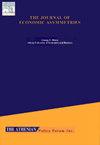Monetary alignment or divergence? - Exchange rates and economic dynamics in non-euro European countries
Q1 Economics, Econometrics and Finance
引用次数: 0
Abstract
The far-reaching impacts of the euro's introduction in 1999 have reshaped Europe's monetary landscape, extending integration even to non-euro economies. The primary aim of this paper is to examine whether the non-euro European economies are monetarily linked to the Euro Area. Using economic indicators from nine European countries, alongside the Eurozone, and employing SVECM models, this research assesses the degree of monetary integration. The empirical findings strongly indicate that the economies of Poland, Romania, Sweden and Norway have been positively bound and highly integrated with the Eurozone since the euro's launch. Moreover, the economies of Czechia and Hungary have demonstrated a steady and increasing level of monetary integration with the Eurozone over time. In contrast, the economies of Iceland, Switzerland, and the UK exhibit monetary divergence from the Eurozone. Based on these findings, the research proposes that Poland and Romania may need to explore the possibility of joining the Euro Area, while Norway and Sweden may (re)consider their stance on potential EU or EMU membership, respectively. The results underscore that the creation of the Eurozone and the circulation of the euro have played a significant role in facilitating and advancing monetary integration across Europe.
货币政策趋同还是分化?-非欧元欧洲国家的汇率和经济动态
1999年欧元的引入产生了深远的影响,重塑了欧洲的货币格局,甚至将一体化扩展到了非欧元经济体。本文的主要目的是考察非欧元区的欧洲经济体是否与欧元区有货币联系。本研究使用来自9个欧洲国家和欧元区的经济指标,并采用SVECM模型来评估货币一体化程度。实证研究结果强烈表明,自欧元启动以来,波兰、罗马尼亚、瑞典和挪威的经济与欧元区有着积极的联系和高度的融合。此外,随着时间的推移,捷克和匈牙利的经济与欧元区的货币一体化水平稳步上升。相比之下,冰岛、瑞士和英国的经济表现出与欧元区的货币差异。基于这些发现,研究建议波兰和罗马尼亚可能需要探索加入欧元区的可能性,而挪威和瑞典可能(重新)考虑他们对潜在的欧盟或欧洲货币联盟成员的立场。结果强调,欧元区的创建和欧元的流通在促进和推进整个欧洲的货币一体化方面发挥了重要作用。
本文章由计算机程序翻译,如有差异,请以英文原文为准。
求助全文
约1分钟内获得全文
求助全文
来源期刊

Journal of Economic Asymmetries
Economics, Econometrics and Finance-Economics, Econometrics and Finance (all)
CiteScore
4.80
自引率
0.00%
发文量
42
审稿时长
50 days
 求助内容:
求助内容: 应助结果提醒方式:
应助结果提醒方式:


